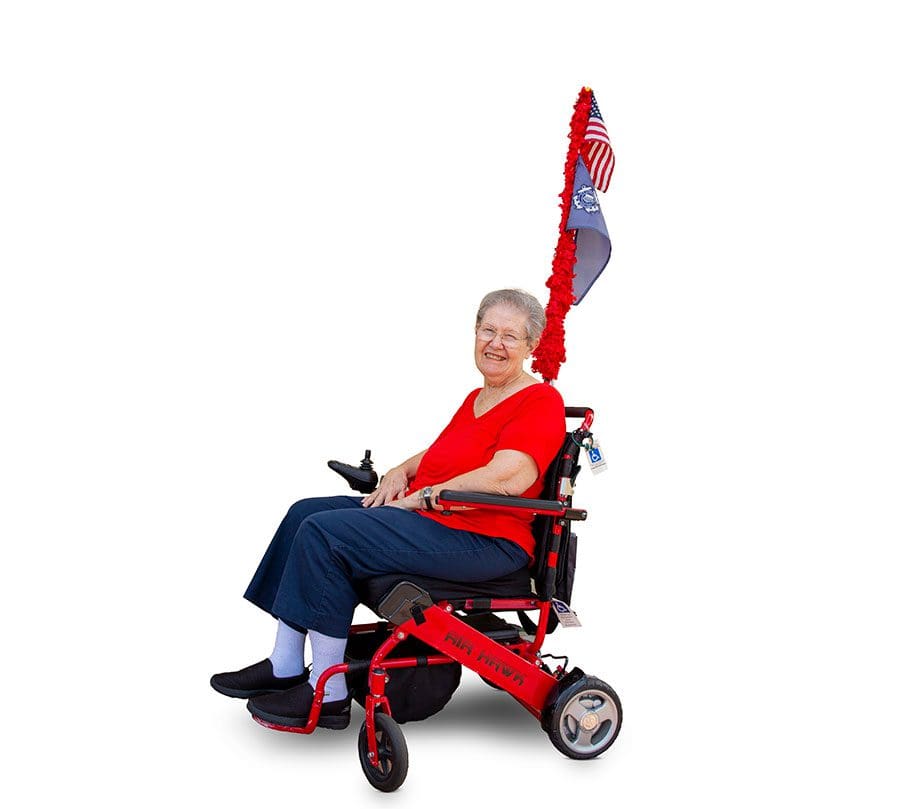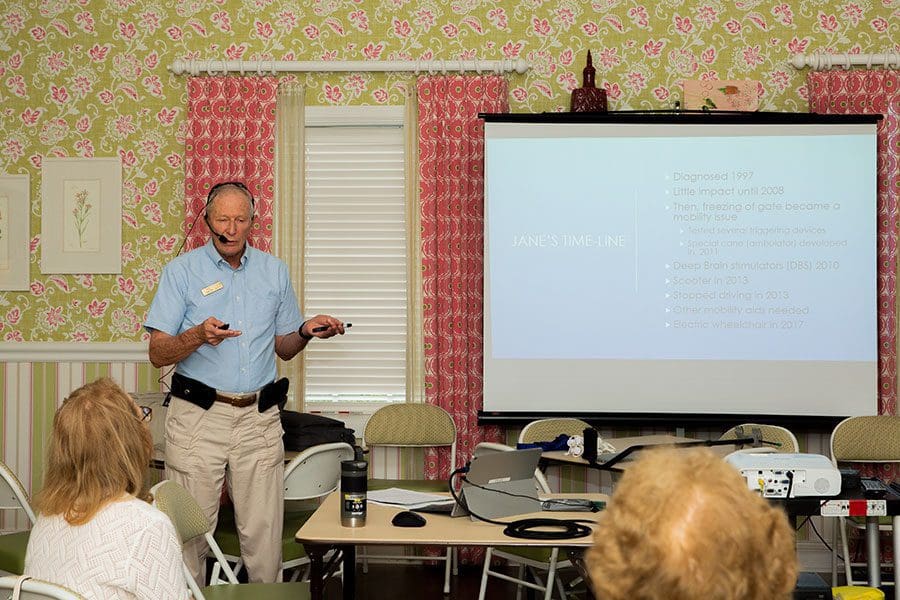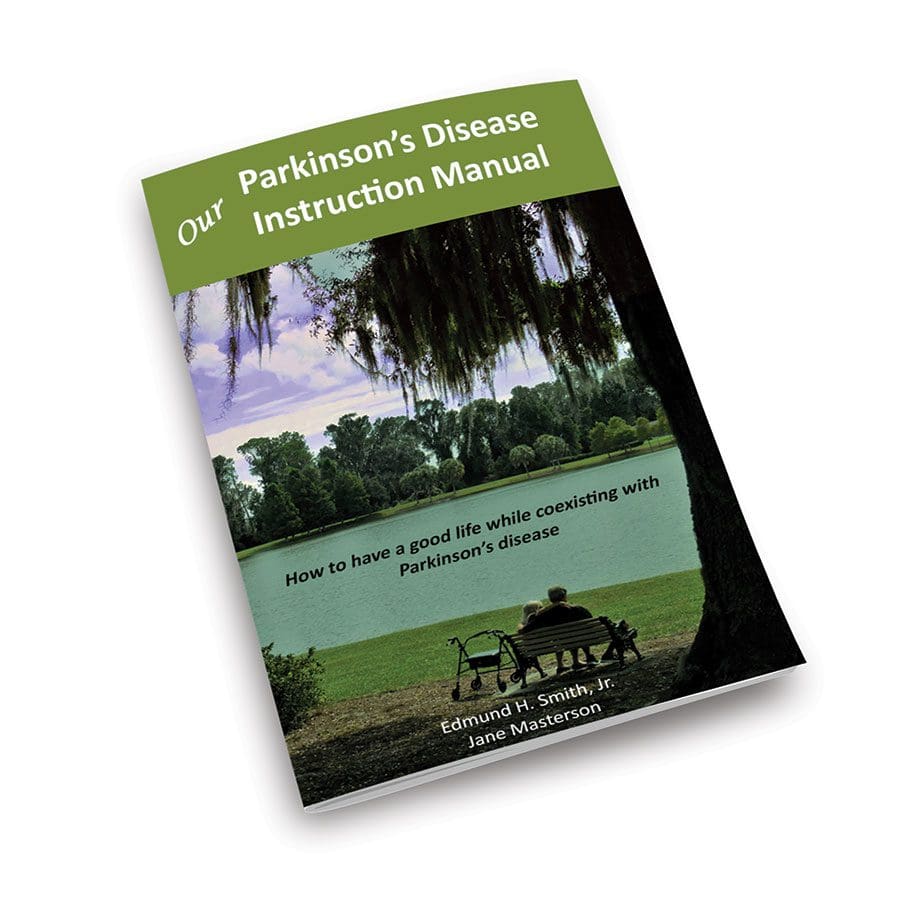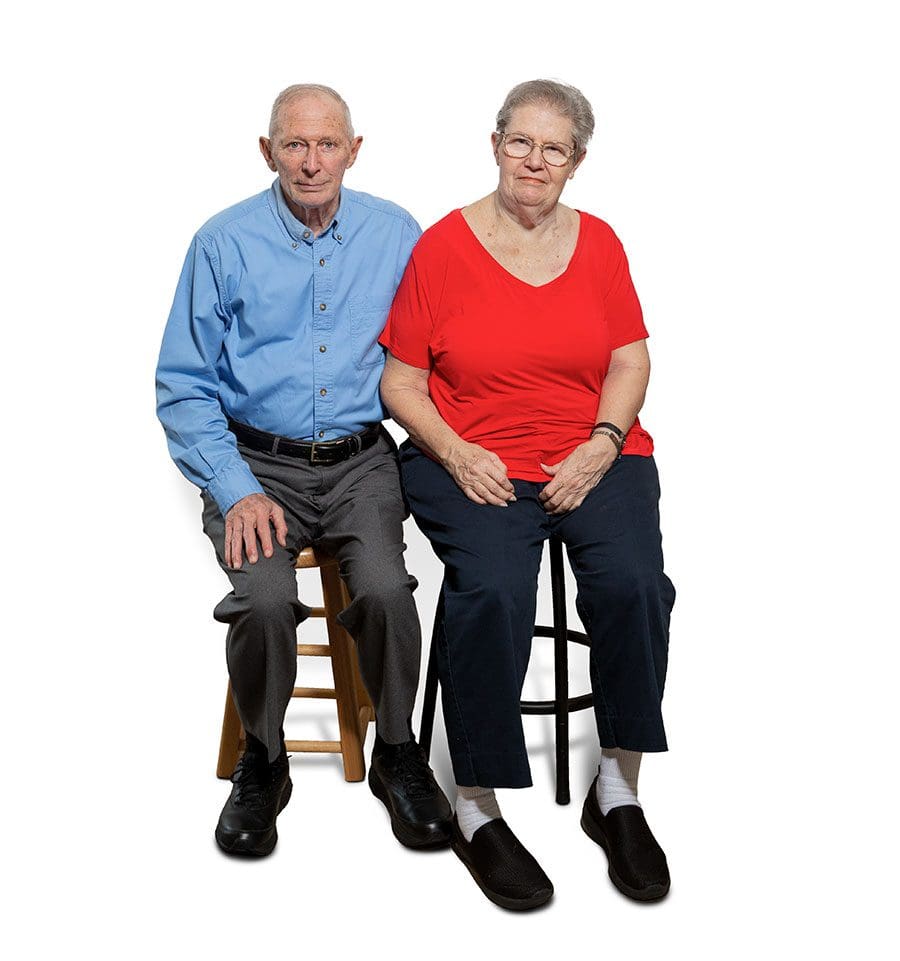
By Akers Editorial
Take a page from their book

A Parkinson’s disease patient and her caregiver have written a book to help patients live their best lives physically and emotionally.
Photos: Nicole Hamel
Jane Masterson has spent the past 25 years living with Parkinson’s disease, an unglamorous, degenerative neurological condition that has led to endless doctor’s appointments, several hospitalizations, and dismal symptoms.
Her partner and caregiver, Ed Smith, has faithfully remained by Jane’s side throughout her battle, accompanying her to medical appointments and installing safety features throughout the home to keep her from falling. The caregiver role has brought on unwanted bouts of stress and brain fog.
But neither Ed, 80, nor Jane, 76, have dwelled on a life of suffering. Instead, they accepted the challenges of the life-changing disease, creating a new normal that has allowed them to continue leading meaningful lives.
Since Jane’s diagnosis, they’ve enjoyed beautiful views from the decks of cruise ships, rescued boaters in distress as volunteers for the U.S. Coast Guard Auxiliary, and have given numerous presentations on Parkinson’s disease, providing inspiration and encouragement to others dealing with the affliction.
“You can have a good life with this disease,” Ed says. “You have to adapt, you have to change, and you have to learn new things.”
Now, they want that message of hope to reach thousands of Parkinson’s disease patients and their caregivers.
Ed and Jane published a book, “Our Parkinson’s Disease Instruction Manual: How to have a good life while living with Parkinson’s disease.” In the 24-chapter book, which was released in November 2021, they draw from their education, research, and personal experiences with the disease to cover multiple topics: modifying the home to enhance safety, using scooters and wheelchairs to increase mobility, obtaining adequate medical care, and engaging in exercise to slow the disease’s progression, among others.
“We have no objective of making money with the book,” Ed says. “The book is priced in a way that royalties are very small. With whatever royalties we get, we are going to buy additional books and give them out to Parkinson’s patients and caregivers.”
The book, they say, is beneficial for all Parkinson’s patients. First, it answers questions typically asked by those who are newly diagnosed and encourages those who have had the disease for years to lead a better quality of life. Second, unlike afflictions such as Alzheimer’s or amyotrophic lateral sclerosis (ALS), patient can survive decades with Parkinson’s. Therefore, understanding how to live well with the disease is crucial.
“The book covers topics that the medical community may not have time to discuss with patients,” Jane says. “Yet, these topics are important because they help patients and caregivers cope with the disease and live their best lives possible.”

Successfully co-existing with Parkinson’s
At age 53, Jane knew something was wrong when her handwriting became indecipherable. In fact, her bank rejected a check she had written, claiming the signature did not match the one on file. She also noticed that her right arm would rest stiffly across her stomach as she walked instead of swinging naturally.
In January 1997, she was diagnosed with early-onset Parkinson’s disease, a chronic neurological disorder resulting from degeneration and premature death of dopamine-producing cells in the substantia nigra, a peanut-sized region in the center of the brain that modulates conscious movement. Nearly 1 million people in the U.S. live with the disease, and approximately 60,000 are diagnosed each year, according to the Parkinson’s Foundation.
Though the medical community classifies the disease as a movement disorder, symptoms can run the gamut from vision changes and memory loss to speech difficulties and bowel control problems.
“There are 42 symptoms associated with Parkinson’s, and Jane has experienced 40 percent of them,” Ed says.
Of course, many of those symptoms took years to manifest, allowing Ed and Jane to enjoy fun-filled lives together for years following her diagnosis. They became partners after Ed, who has a master’s degree in electrical engineering, retired from a 40-year career as a scientist and engineer.
“I had known Jane for years,” Ed says. “One day I called her up and said, ‘You know, I don’t really want to work anymore. Would you like to accompany me on my 38-foot trawler boat and travel down the intracoastal waterway from the northern Chesapeake Bay to the west coast of Florida?’ She said yes, and we’ve been together ever since.”
That first boat ride certainly wasn’t their last. Being on the water brought them peace, and, in a sense, helped them temporarily escape the reality of Jane’s condition. Ed and Jane built a home in the waterfront community of Punta Gorda Isles and five years later purchased a second home in Knoxville on the Tennessee River.
The partners took frequent boat trips along Florida’s west coast to cities such as Sarasota, Tampa, Naples, and Marco Island. They also became volunteers for the Coast Guard Auxiliary. Jane qualified to serve as a boat crew member on small patrol boats and later qualified to serve as a ground station radio operator. Ed became a patrol boat commander.
“We did this in both Punta Gorda and Knoxville, and our jobs were to look for vessels in distress,” Ed says. “We joined the Coast Guard Auxiliary because we wanted to be active and in something. In a strange way, we rarely thought about her disease because we were so involved. It’s better than feeling sorry for yourself, sitting around, and doing nothing.”
Nor did they allow the disease to keep them from traveling. Ed and Jane have spent more than 500 days aboard cruise ships or river boats, experiencing new places and cultures and meeting new people. With a little pre-planning—like booking a handicap cabin months in advance and arranging for Jane to have a bedside commode—they successfully minimized Parkinson’s disease mishaps.
“Cruises are perfect for a Parkinson’s patient and caregiver because you don’t have to worry about food preparation, and you only have to pack and unpack once,” Ed says. “Our favorite cruise lasted 35 days on Voyage of the Vikings. We went into Labrador, Greenland, Iceland, and Norway. It was such a fabulous cruise that we did it again several years later.”
However, there came a time when Jane was forced to accept the harsh reality of the disease. Though Parkinson’s disease is not a fatal illness, it’s a degenerative disorder that progresses and affects all body movements, including posture, strength, balance, and endurance. The symptoms begin to interfere with daily activities.
For Jane, traveling is no longer feasible. She requires a wheelchair, scooter, or walker for mobility. Grab bars in the shower keep her from falling, and vehicle support handles help her get in and out of an automobile’s passenger side. She has suffered several falls, one of which put her in the hospital for three days followed by an additional seven days of rehabilitation.

You’re better off talking about it
Even as Jane’s condition progressed, they shunned pity and instead found their voice in helping others overcome the same challenges. In 2016, Ed and Jane joined a Parkinson’s support group in Punta Gorda. Ed, whose extensive research led him to become a lecturer and educator for Parkinson’s disease, gave a presentation titled “Ideas for Living Well with Parkinson’s Disease.” Since then, he has given the same presentation throughout Florida’s west coast, in eastern Tennessee, and at impromptu gatherings on cruise ships.
“The presentation really inspires people who are newly diagnosed with the disease because, for them, it’s a time of fear and uncertainty,” Jane says. “The presentations are really upbeat, and we tell them about our story and how you can still live a rewarding life. Giving these presentations is just as rewarding for us because we’re giving people hope.”
In 2019, they moved to The Villages to be within a short driving distance of the Norman Fixel Institute for Neurological Disease, which is located in Gainesville and designated as a Parkinson’s Foundation Research Center for Excellence. Ed estimates that The Villages, the nation’s largest retirement community, has 1,600 residents with Parkinson’s disease. For them, it was an opportunity to share their story with more Parkinson’s patients and caregivers.
Ed gave seven presentations in The Villages in 2021, limiting the audience size to 16 people to assure lively discussion. Cynthia Gay, a resident of The Villages, attended one of those presentations shortly after her partner, Van Sewell, was diagnosed with Parkinson’s disease.
“Their presentation was very thorough, pragmatic, and helpful,” Cynthia says. “It left me saying, ‘OK, they have battled this disease for 25 years, so I know Van and I can do the same.’ After a Parkinson’s diagnosis, there are three stages: fear, learning, and
growth. We were still in the fear stage. However, the presentation pushed us into the learning phase because it was done in a way where Ed inspired so much hope.”
Following the presentation, a teary-eyed Cynthia approached Ed and asked him to write a book using all the information he just shared.
“Some people learn visually, and some people learn auditorily,” Cynthia says. “As a caregiver for a Parkinson’s patient, I thought it would be great to have a book with useful information that I could put my fingertips on at all times.”
Conveniently enough, Cynthia happened to be a former English teacher for the U.S. Department of Defense and agreed to edit the book.
“The book is full of valuable information, and I think readers will appreciate Jane’s bravery in dealing with the disease and Ed’s kindness toward her,” Cynthia says. “It’s pragmatism injected with heart.”
Jane also asked her longtime friend, Elizabeth Costello, to proofread and copy edit the book. Elizabeth, a resident of Syracuse, New York, earned a master’s degree in English from Purdue University and has edited autobiographies for refugees who escaped South Sudan.
“I thought their book turned out wonderful,” Elizabeth says. “They wrote it in a conversational way that it feels like they are speaking directly to you. They don’t confuse readers with medical terminology and medical jargon. They’ve dealt with this disease so beautifully, and that comes across loud and clear in the book.”

The write stuff
The book provides common sense and practical advice to help patients and caregivers. Using a pragmatic and personal tone, Ed and Jane offer knowledge and wisdom from the challenges they’ve faced with Parkinson’s disease for 25 years.
It is available on Amazon.com in paperback for $11.95 and hardcover for $29.95.
“Our book is one of the highest-rated books right now on Amazon for Parkinson’s disease,” Ed says. “However, I have to qualify that. The book has only been out for several months. I think the reason the response has been so good is because it is loaded with practical tips on living your best life with this disease.”
Their written message is enhanced by more than 35 photographs of items they find useful in their everyday battle, such as bedside commodes and a bed rail and bed ladder. There are also pictures from their cruises, as well as one of Jane sitting happily in her faithful red scooter. The scooter has LED lights and two safety flags—one American flag and one of the Coast Guard Auxiliary—that add visibility and flair.
“When people are driving, they tend not to look down, so they don’t see people in scooters or wheelchairs,” Jane says. “The flags ensure that people see me when I’m riding my scooter in a public parking lot. However, the scooter and flags have also become part of my exterior personality. Four years ago, we left for a cruise out of Tampa, and one of the cruiser workers saw me in the scooter and said, ‘Hi. Welcome back!’ The cruiser worker remembered me by my scooter.”
There are heartwarming stories, too. One chapter is devoted to their adorable cats, Nefertiti, Chocolate Drop, and Muffin. Actually, they’re stuffed animals. But they bring Ed and Jane just as much pleasure as a real pet.
“Having a real cat would add to the risk of me falling,” Jane says. “However, we love our stuffed animals just as much. They’ve been on cruise ships with us and have been to the Artic Circle with us. On one trip down the Mississippi River, a cabinet attendant took great delight in dressing up our kitties. Each day, she would put a different outfit on them.”
Another chapter explains how Ed finds relief from his taxing duties as a caregiver. He does all the shopping, cooking, and driving.
“She can no longer drive because Parkinson’s patients lose their ability to multi-task,” Ed says. “As far as cooking, the kitchen is the second-most dangerous room in the house for a Parkinson’s patient. Imagine someone in a wheelchair with a movement disorder trying to use a sharp knife or reaching for a hot pot. I no longer let Jane in my kitchen.”

Though Ed’s world revolves around unending demands, he does enjoy some occasional free time to himself. Jane has a companion who visits for days or weeks at a time, allowing Ed to fly radio-controlled model airplanes, shoot air guns with friends at a local range, or take three-day cruises by himself. Sometimes, short walks help rid him of stress. Sleeping in a separate bedroom from Jane ensures he receives adequate rest.
“Through research, I’ve discovered that 70 percent of caregivers over the age of 70 die before the person they are taking care of,” Ed says. “If I died or became ill, Jane would be forced to move into a nursing home or assisted-living facility. I have to take care of myself. Psychiatrists and psychologists say that caregivers need one day a week to themselves, need one long weekend each month to themselves, and every three months they need an entire week to themselves.”
The book has received positive reviews from readers like Rose Lang, whose husband, John, was diagnosed with Parkinson’s disease 14 years ago. She volunteers for the Parkinson’s Foundation’s Aware in Care program, which distributes informational kits to Parkinson’s patients to help them advocate for better care when hospitalized.
“The book is all about living well with Parkinson’s, but people who are newly diagnosed have no idea how to do that,” says Rose, a resident of The Villages. “I found the book to be an informative guide on navigating the day-to-day journey.”
Carolyn McDermott, who also lives in The Villages, was touched after reading the book. Although nobody in her immediate family is afflicted with Parkinson’s, she admires the way Ed and Jane share their knowledge and experiences to help others cope with the disease.
“I read the book in one sitting because I couldn’t put it down,” she says. “It’s not a dry medical textbook; it’s chalk full of antidotes, photos, and, most importantly, useful information that your doctor many not provide. The one thing you take away after reading the book is that there is hope for Parkinson’s patients.”
For Ed and Jane, losing hope is never an option.
“I’m optimistic that there’s going to be a cure for Parkinson’s within 10 years or so,” Ed says. “I don’t have the medical qualifications to state that, but I think our science will find a cure. There are a fair number of Parkinson’s research projects going on, so we choose to be hopeful.”
Parkinson’s disease by the numbers
- The combined direct and indirect cost of Parkinson’s, including treatment, social security payments, and lost income, is estimated to be nearly $52 millioin the U.S.
- 4% of Parkinson’s patients are diagnosed before age 50.
- Men are 1.5 times more likely to have Parkinson’s disease than women.
- More than 10 million people worldwide live with the disease.
- 1.2 million Americans are expected to have Parkinson’s disease by 2030.
Source: Parkinson’s Foundation
Signs and symptoms of Parkinson’s disease include:
- A tremor or shaking in a limb, often a hand or finger.
- Slowed movement.
- Rigid muscles
- Impaired balance and posture.
- Loss of automatic movements, such as blinking or smiling.
- Speech changes.
- Writing changes.
Source: Mayo Clinic









My wife, Eleanor Johnston, a PD patient for over 15 years, has published a novel about living with Parkinson’s. Shaking Parkinson’s is available on Amazon. Readers of Ed and Jane’s book might find this novel approach inspiring and instructional.
My grandma has Parkinson’s disease, she is about 75 years old it was detected 7 years ago. Right now it’s getting more difficult to live for her, because of stiff muscles she can’t even move. L-dopa and carbidopa medicines are given, but won”t give much relief. She can”t eat food and the skin is damaging forming ganglia. I thought this might be the last stage and the medications she was given did not help at all, so I started to do alot of research on natural treatments and came across Parkinson’s Herbal Treatment from Health Natural Centre ( health natural clinic .org ), the treatment has made a very huge difference for her. Her symptoms including body weakness and her tremors disappeared after few months on the treatment. She is getting active again since starting this treatment, she is able to walk again ( down the street and back ) and able to ride her treadmill again. God Bless all PD Caregivers. Stay Strong, take small moments throughout the day to thank yourself, to love your self, and pray to whatever faith, star, spiritual force you believe in and ask for strength.